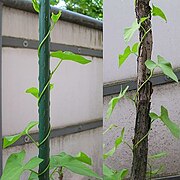creeper
A creeper - also called a winder - is a climbing plant that climbs on a support with the help of its twisting shoot. Their natural supports are other plants, preferably grasses and slender, emerging trees, but also hanging climbing plants or lianas. Looping or winding is one of four climbing forms or climbing strategies that enable plants to grow in height without developing sufficiently stable stems or trunks. Depending on the plant loops in which direction to their support, we distinguish links Winder and legal Winder . Very few species can switch back and forth between left-hand and right-hand turns. In the botanical literature there is no consensus as to which type is called a left winder and which is a right winder. The following definitions exist:
View from above
This definition is based on the observation of the screwing movement from above. It is mainly used in older florists.
Left-hand winds or left-hand winds are those twisting climbing plants , the tip of which, when viewed from above, circles counterclockwise around a climbing pole. Their growth creates a right-handed helix or screw. The true bindweed and the pole bean are left winders according to this definition.
Right-hand winds or right-hand winds are those winding climbing plants, the tip of which, when viewed from above, circles clockwise around a support. As they grow, a left-handed helix or screw is created. According to this definition, the flies and the hops are right- wingers .
Scientific and technical approach
This definition follows general scientific and technical usage.
Right-hand winders or right-hand screw winders thus form a right-hand screw (i.e. a screw with a right-hand thread). They are also called "bean-like" after the bean .
Left-hand winders or left-hand screw winders therefore form a left-hand screw (i.e. a screw with a left-hand thread). They are also called "hopfisch" after the hops .
In the mathematical sub-area of differential geometry , especially in the older literature, space curves are called vinous or hoppy if the winding direction of the curves behaves like the tendrils of wine or the twisting shoot axes of hops. The tendrils of grapevines, however, have no fixed sense of screwing. As soon as they have found support, they - necessarily - even develop a “turning point” roughly in their middle.
The assertion that the number of types of right-hand screw winders is higher than that of left-hand screw winds is occasionally found. Whether this actually applies to the many different species of winding plants and lianas around the world remains to be researched; in particular how often a left or right winding was "invented" independently of each other. So z. B. all the many right- winding Dioscorea species are counted as 1 case.
The rotation of the tip of the drive around an existing or imaginary vertical axis occurs i. d. Usually due to different growth in length of the cells on two opposite shoot sides. The relative length difference on both sides of the shoots, or on the inside and outside, is constant. This means that the wind movement of each looping species occurs at the same speed under different growing conditions. A complete rotation of the tip of the shoot takes a few hours to about half a day, depending on the species. The increase in length of the shoots within this period results in a slope of the winding, according to the growth conditions. If these worsen, e.g. B. due to dryness or cold (autumn), the slope decreases - the windings become visibly tighter.
Due to their climbing shape, climbing plants are preferred for facade greening, which should have a predominantly horizontal spread.
Individual evidence
- ↑ Wind plants, Ulm University
- ^ Manfred A. Fischer, Karl Oswald, Wolfgang Adler: Excursion flora for Austria, Liechtenstein and South Tyrol . 3rd, improved edition. State of Upper Austria, Biology Center of the Upper Austrian State Museums, Linz 2008, ISBN 978-3-85474-187-9 . , P. 67
- ↑ Wolfgang Kühnel : Differential Geometry. Curves - surfaces - manifolds. 4th revised edition. Friedr. Vieweg & Sohn Verlag, Wiesbaden 2008, ISBN 978-3-8348-0411-2 , Section 2.8: Space curves

